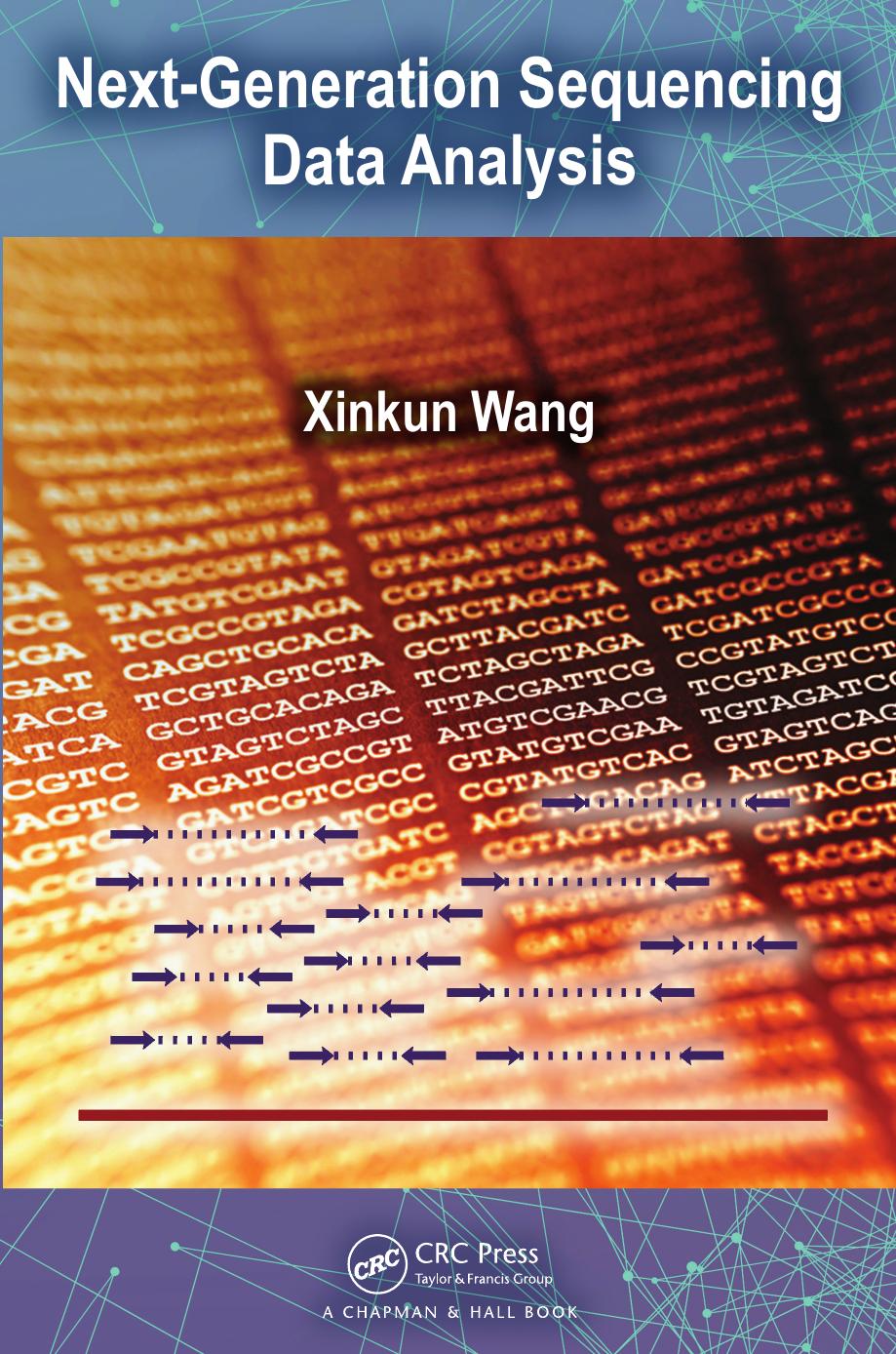Next Generation Sequencing Data Analysis 1st edition by Xinkun Wang ISBN 1482217880 978-1482217889
$70.00 Original price was: $70.00.$35.00Current price is: $35.00.
Instant download Next Generation Sequencing Data Analysis after payment
Next Generation Sequencing Data Analysis 1st edition by Xinkun Wang – Ebook PDF Instant Download/Delivery: 1482217880, 978-1482217889
Full download Next Generation Sequencing Data Analysis 1st edition after payment

Product details:
ISBN 10: 1482217880
ISBN 13: 978-1482217889
Author: Xinkun Wang
A Practical Guide to the Highly Dynamic Area of Massively Parallel Sequencing
The development of genome and transcriptome sequencing technologies has led to a paradigm shift in life science research and disease diagnosis and prevention. Scientists are now able to see how human diseases and phenotypic changes are connected to DNA mutation, polymorphism, genome structure, and epigenomic abnormality. Next-Generation Sequencing Data Analysis shows how next-generation sequencing (NGS) technologies are applied to transform nearly all aspects of biological research.
The book walks readers through the multiple stages of NGS data generation and analysis in an easy-to-follow fashion. It covers every step in each stage, from the planning stage of experimental design, sample processing, sequencing strategy formulation, the early stage of base calling, reads quality check and data preprocessing to the intermediate stage of mapping reads to a reference genome and normalization to more advanced stages specific to each application. All major applications of NGS are covered, including:
- RNA-seq: mRNA-seq and small RNA-seq
- Genotyping and variant discovery through genome re-sequencing
- De novo
genome assembly
- ChIP-seq to study DNA–protein interaction
- Methylated DNA sequencing on epigenetic regulation
- Metagenome analysis through community genome shotgun sequencing
Before detailing the analytic steps for each of these applications, the book presents the ins and outs of the most widely used NGS platforms, with side-by-side comparisons of key technical aspects. This helps practitioners decide which platform to use for a particular project. The book also offers a perspective on the development of DNA sequencing technologies, from Sanger to future-generation sequencing technologies.
The book discusses concepts and principles that underlie each analytic step, along with software tools for implementation. It highlights key features of the tools while omitting tedious details to provide an easy-to-follow guide for practitioners in life sciences, bioinformatics, and biostatistics. In addition, references to detailed descriptions of the tools are given for further reading if needed. The accompanying website for the book provides step-by-step, real-world examples of how to apply the tools covered in the text to research projects. All the tools are freely available to academic users.
Next Generation Sequencing Data Analysis 1st Table of contents:
-
Introduction to Next-Generation Sequencing (NGS)
- Overview of Next-Generation Sequencing Technologies
- Applications of NGS in Genomics, Transcriptomics, and Epigenomics
- Basic Principles of NGS: From Sample Preparation to Sequencing
- NGS Platforms and Technologies: Illumina, PacBio, Oxford Nanopore, etc.
-
NGS Data Types and File Formats
- Raw Data: What to Expect from NGS Outputs
- Overview of Common NGS File Formats (FASTQ, BAM, VCF, GFF)
- Understanding Quality Scores and Base Calling
- Data Preprocessing: Quality Control and Filtering
-
Preprocessing and Quality Control of NGS Data
- Quality Assessment of NGS Reads
- Trimming, Filtering, and Adaptor Removal
- Visualizing and Evaluating Sequencing Quality (FastQC, MultiQC)
- Error Correction in NGS Data
-
Alignment and Mapping of NGS Reads
- Understanding Sequence Alignment: Mapping vs. Assembly
- Algorithms for Sequence Alignment (BWA, Bowtie, STAR, etc.)
- Mapping NGS Reads to Reference Genomes
- Handling Gaps and Mismatches in Alignments
-
Variant Calling and Annotation
- Identification of Single Nucleotide Polymorphisms (SNPs), Indels, and Structural Variants
- Tools for Variant Calling (GATK, SAMtools, FreeBayes)
- Variant Annotation and Interpretation (ANNOVAR, SnpEff)
- Quality Control in Variant Calling
-
Transcriptome Analysis and RNA-Seq
- Overview of RNA-Seq: From Raw Data to Biological Insights
- Alignment of RNA-Seq Reads and Quantification (TopHat, HISAT2, STAR)
- Differential Gene Expression Analysis (DESeq2, edgeR)
- Transcript Isoform Discovery and Alternative Splicing Analysis
-
ChIP-Seq and Epigenomic Data Analysis
- Introduction to ChIP-Seq and Epigenomic Applications
- Quality Control and Preprocessing of ChIP-Seq Data
- Peak Calling and Identification of Regulatory Regions (MACS, SICER)
- Integrating ChIP-Seq Data with Other Omics Data (RNA-Seq, DNA Methylation)
-
Metagenomics and Microbiome Data Analysis
- Introduction to Metagenomics and Its Applications
- NGS in Microbiome Profiling
- Sequence Assembly and Taxonomic Classification (QIIME, Kraken)
- Functional Analysis of Microbiome Data
-
De Novo Assembly of NGS Data
- Principles of De Novo Assembly: When to Use It
- Assembly Algorithms and Tools (SPAdes, Velvet, SOAPdenovo)
- Evaluating the Quality of Assembly (N50, Contig Length, Genome Coverage)
- Annotation of Assembled Genomes
-
Genetic and Structural Variation Analysis
- Detecting Structural Variants (SVs) Using NGS
- CNV (Copy Number Variation) Detection Methods
- Whole-Genome vs. Targeted Sequencing for Variant Detection
- Integrating NGS with Cytogenetics and Imaging
-
Long-Read Sequencing Data Analysis
- Unique Challenges of Long-Read Sequencing (e.g., PacBio, Oxford Nanopore)
- Error Profiles and Base Calling in Long-Read Data
- Assembly and Mapping Techniques for Long-Read Data
- Applications of Long-Read Sequencing in Complex Genomes
-
Data Integration and Functional Genomics
- Integrating NGS Data with Other Omics Data (Proteomics, Metabolomics)
- Pathway and Network Analysis Using NGS Data
- Data Visualization and Interpretation (R, Bioconductor, IGV)
- Systems Biology Approaches to NGS Data
-
Advanced Topics in NGS Data Analysis
- Single-Cell RNA-Seq Analysis and Applications
- Spatial Transcriptomics and Imaging-Based Genomics
- Longitudinal Data Analysis and Time-Series Sequencing
- Machine Learning and AI in NGS Data Interpretation
-
Tools and Software for NGS Data Analysis
- Open-Source and Commercial Software for NGS Data Analysis
- Cloud Computing for Large-Scale NGS Data Analysis
- High-Performance Computing (HPC) in NGS Workflow Management
- Pipelines for Automated NGS Data Analysis
-
Clinical Applications of NGS
- Precision Medicine and NGS
- NGS in Cancer Genomics and Personalized Treatment
- Diagnostic and Prognostic Biomarkers
- Ethical and Legal Considerations in Clinical NGS
-
Conclusion and Future Directions
- Emerging Trends in NGS Technologies and Data Analysis
- Challenges in Big Data Analysis and Storage for NGS
- The Future of NGS in Medicine, Agriculture, and Environmental Studies
- Ethical and Regulatory Issues in NGS
-
Appendices
- A: Glossary of NGS Terms and Acronyms
- B: Additional Resources and Online Databases
- C: Recommended Software Tools and Pipelines
-
Index
People also search for Next Generation Sequencing Data Analysis 1st :
bioinformatics a practical guide to next generation sequencing data analysis
computational methods for next generation sequencing data analysis
next generation sequencing data analysis course
next generation sequencing data analysis pdf
next generation sequencing data analysis xinkun wang pdf
Tags:
Xinkun Wang,Next Generation,Sequencing Data


